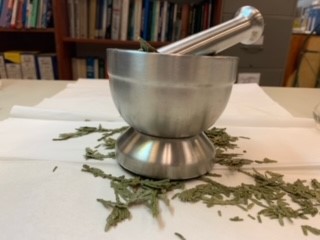
Cedar Thuja plicata

Cedar Thuja Plicata
Thuja Plicata is the largest species in the genus thuja as it can grow up to 70 m tall, and 7 m in diameter. The species is shade-tolerant and can establish in the forest understories which results in the plant being a very long-lived tree, with some that can live well over 1,000 years. The Thuja Plicata plant has many different important purposes. The wood is resistant to decay and therefore makes it a good material to make shingles, furniture, fence poles, and canoes. The natural plant extracts of the Thuja Plicata found are very fragrant. They are extracted and used for different perfumes and soaps, and can even be used in the process of refining lead.1

My name is Amy and I am a grade 11 student from Labrador (May, 2023). I was given the opportunity to visit uOttawa for a week and learn about plant hydrosols. I have always had an interest in chemistry and its role in plants, so I am very grateful that I got to participate in this research. I worked with some grad students under the supervision of Sharon Curtis and Paul Mayer, and had one of the best experiences of my life with regards to academics. My goal for after graduation is to go into kinesiology, followed by physiotherapy. After this experience in the lab, on campus, and working with the wonderful people that I have met, uOttawa is definitely a possibility for my future. During my time at uOttawa, I got to study cedar in the Department of Chemistry and Biomolecular Sciences. We used microwave distillation/extraction to retrieve the hydrosol and prepared the samples. The samples were put through the GC/MS to discover the molecules present in the cedar hydrosol.

Cedar Thuja Plicata. What's in it?
Distillation of the cedar leaves was created using the microwave device.
Nearly 1 litre of hydrosol was collected through 3 x 9 minute sessions in the microwave. A thin layer of oil floated on the top of the water. The smell was pungent.
Thujone was the most abundant in the cedar sample. It has a molecular weight of 152.23 g/mol and contains a five-membered ring, connected to a three-membered ring. Thujone was found in a popular drink from the 19th and 20th centuries, called absinthe. It is considered to have adverse health effects, due to the toxicity of thujone in large amounts. This molecule is also known to have insecticidal properties. Through GC analysis, 4-terpineol was also found in the cedar sample. This compound is widely regarded as the most important of the 15 major components of tea tree oil and is used worldwide for its cosmetic and medicinal properties. Demodex is a species of microscopic mites that is abundant on human skin and eyelashes. When applied, 4-terpineol does not cause skin or eye irritation, and instead is a non-toxic chemical and is found to be a safe way at eliminating demodex.2 4-terpineol has antimicrobial and antiseptic properties.
Verbenone was also found in the cedar sample. It is used as a flavoring and fragrance agent (perfumery, herbal teas, spices). The main use of verbenone is for a short-term treatment to protect individual pine trees from mountain pine beetle (MPB) attack. The verbenone is naturally produced from the MPB as an anti-aggregation pheromone to diffuse adult beetles away from the trees in the forest.3 Without the production of verbenone, the potential of tree mortality increases for red and white pine trees which will reduce habitat for native wildlife.4
By Amy and James Moaddel
References 1) Verlinde, S. (n.d.). Thuja Plicata. Retrieved May 15, 2023, from https://www.wnps.org/native-plant-directory/326:thuja-plicata#:~:text=Material%20Uses %3A%20Western%20redcedar%20is,%2C%20and%20wood%20pulp%2Fchips. 2) Team, T. C. (2022, February 23). 4-terpineol: What is it & how does it work in CLIRADEX products?. Cliradex®. Retrieved May 15, 2023, from https://cliradex.com/blog/4-terpineol-work-cliradex-products/ 3) Invasive Species Center. (2023, March 27). Mountain Pine Beetle - profile. Mountain Pine Beetle. Retrieved May 15, 2023, from https://www.invasivespeciescentre.ca/invasive-species/meet-the-species/invasive-insects/ mountain-pine-beetle/#:~:text=If%20the%20beetle%20spreads%20east,reduce%20habita t%20for%20native%20wildlife. 4) United States Department of Agriculture Forest Service. (n.d.). Home | US Forest Service. Using Verbenone to Protect Trees from Mountain Pine Beetle. Retrieved May 15, 2023, from https://www.fs.usda.gov/Internet/FSE_DOCUMENTS/stelprdb5373188.pd

Amy, created a bug repellant called "Bugger Off:.
The recipe:
60ml of Cedar Hydrosol.
60ml of distilled water.
20ml of a solubiliser.
Essential oils.
5 drops Cedar wood
4 drops Opopanax
4 drops Patchouli
3 drops Eucalyptus
2 Spikenard